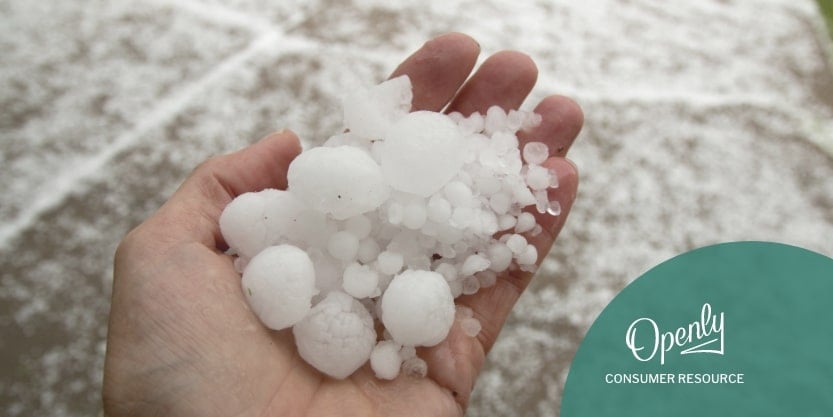For the majority of homeowners across the country, the threat of natural disasters is never all that far away, if not increasingly annually. In certain regions, hail storms are a common occurrence, causing extensive damage to homes, personal property and more. In fact, recent statistics show that the United States experiences over 3,000 hail storms annually, with an estimated cost of damages exceeding $10 billion each year.1
From general storm damage to siding and roof damage, keep reading to explore the nuances between home insurance and hail damage, how to file a hail damage claim, and factors for homeowners to keep in mind. Equipping yourself with essential knowledge is the first step in preparing for hail damage, including the intricacies surrounding comprehensive coverage, roof replacement and more. By explaining the science behind hail formation and deciphering the terms of your insurance policy, we aim to empower homeowners with the insights needed to navigate hail storms successfully.
At a glance:
- With over 3,000 hail storms occurring annually, homeowners need to be aware of the potential risks of hail to their properties.
- Investing in impact-resistant roofing materials, reinforcing vulnerable areas, and maintaining regular upkeep of your home and property can significantly reduce the risk of extensive hail damage.
- Understanding the nuances of deductibles empowers homeowners to manage insurance costs effectively while ensuring comprehensive coverage against hail damage.
Understanding hail damage: what homeowners should know
Understanding potential risks is integral to protecting your home. When it comes to natural disasters, hail storms can be especially damaging, causing significant damage to roofs, siding, and other vulnerable features of your home.
The science behind hail formation
Hail is formed through a complex process within thunderstorms. These typically occur in environments prone to updrafts, where thunderstorms can carry raindrops into extremely cold areas of the atmosphere, causing them to freeze. Updrafts occur when warm air rises rapidly, carrying raindrops higher until they freeze into ice pellets, which can range in size.2 These frozen raindrops are lifted and dropped multiple times within the storm cloud, layers of ice accumulate, forming hailstones of varying sizes.
Fun Fact: The largest hailstone ever recorded in the United States weighed in at a whopping 1.9 pounds!3
As hail is carried within the thunderstorm clouds, it can grow larger and larger until they become too heavy and fall to the ground; the larger the hail, the more severe the damage.
Regions most affected by hail storms
Certain regions are more prone to hail storms than others, influenced by a number of geographical and atmospheric factors. For instance, the central United States—including Texas, Oklahoma, and Kansas—has been dubbed "Hail Alley," due to a preponderance of severe hail storms. However, no area is entirely immune to hail, making it essential for homeowners nationwide to consider the potential risks.
It is important to note that all of these factors do not have to be in play for hail to form, and subsequent hail damage to occur. Hail can occur anywhere, under the right conditions, which is why it is imperative that homeowners across the country understand the risks of hail damage and protect themselves and their property appropriately.
Let’s dive into some of the factors that make the central US states so prone to hail:
Geography
The flat landscape of the central United States, when combined with moist air from the Gulf of Mexico can result in severe thunderstorms.5 As previously discussed, hail is formed within thunderstorms so the more severe the storms, the more likely hail is to occur.
Topography
Not to be confused with geography, topography is defined by the physical characteristics of the area. Regions with higher elevation may experience different atmospheric conditions that can increase the propensity of updrafts, resulting in the potential for hail storms.
Weather
Given how hail is formed, areas prone to severe thunderstorms (like the central US states) are more likely to experience hail.
Climate
Areas with more diverse and significant temperature highs and lows (think sweltering summers and freezing winters) may experience more hail due to not only temperature contrasts, but also the change in atmospheric conditions that accompanies seasonal changes.6
Home insurance policies and hail damage coverage
While many standard homeowners insurance policies encompass coverage for hail damage, a closer inspection of your policy is imperative.
Deciphering your policy: what's included and what's not
One of the first questions homeowners often ask is, "Does my insurance cover hail damage?" The answer varies depending on your policy. Most standard homeowners insurance policies do provide coverage for hail damage, however, it's crucial to review your policy and understand the specifics of what is covered.
Standard homeowners insurance policy
As mentioned, most standard homeowners insurance policies typically provide some level of coverage for hail damage. When evaluating your policy, hail damage generally falls under the dwelling coverage (Coverage A), which protects the structure of your dwelling from various perils. Refer to your specific policy to learn more about what perils are or are not covered.
Other structures coverage
Hail damage is not likely to restrict itself to just the main dwelling on your property. If you have other structures, such as detached garages, sheds, or fences, review your policy’s Coverage B to understand the extent of coverage in your insurance policy.
Limitations
Depending on the specifics of your individual homeowners insurance policy, there may be exclusions or limitations to the coverage offered which can impact everything from payouts for repair, to additional living expenses if your home becomes uninhabitable due to hail damage.
It’s important to review your homeowners insurance policy regularly to ensure you have secured adequate coverage for your property, belongings, and dwelling. Contact your insurance agent to discuss any gaps in coverage, or additional endorsements available so that you are protected in the event of storm damage. While hail storms can be expected, they can’t always be predicted which is why it is important to be adequately protected at all times.
The importance of knowing your coverage limits
The importance of knowing your insurance coverage limits cannot be overstated. While hail damage may be covered, paying attention to your insurance policy coverage limits helps you determine whether or not you will be adequately protected when hail damage occurs.
As with many forms of insurance, some homeowners insurance policies may impose ceilings on the amount they will pay for specific damages. Being aware of these limits and taking proactive measures to prevent unwelcome financial surprises when the time comes to file something like a hail damage insurance claim, can help you maintain the financial security that gives you peace of mind.
Navigating claims: steps after hail damage
In the wake of a destructive hail storm, the aftermath can be overwhelming, uncertain, and stressful. As a homeowner, swift and strategic action is your first line of defense against further complications.
Immediate actions to take post-hail storm
Taking immediate action after a hail storm is critical. Inspect your property for visible damage, including dented gutters, broken windows, and, most notably, roof damage. Document the damage with photographs and make temporary repairs to prevent further issues, such as covering broken windows or placing tarps on a damaged roof.
Filing a claim
When filing a hail damage claim, start by contacting your insurance provider as soon as is safely possible. Be sure to provide them with a detailed description of the damage, accompanied by the photographs you took.
Preventative measures and home maintenance
As the saying goes, an ounce of prevention is worth a pound of cure. By staying proactive, you can significantly reduce the risk of extensive damage and weather the storm with greater resilience.
Protecting your home from future hail damage
While you can't control the weather, there are proactive steps you can take to minimize the impact of hail on your home.
Consider installing impact-resistant roofing materials—an investment that not only enhances the durability of your roof but acts as a shield against hailstones. These materials are specially designed to absorb and disperse the force of impact, reducing the likelihood of roof damage and providing an added layer of protection for your home.7
Reinforcing vulnerable areas, such as garage doors and windows, is another important step to take in preventing hail damage. Strengthening these areas through the use of impact-resistant materials or additional protective measures can significantly reduce the risk of structural damage during a hail storm.
Regular maintenance tips to mitigate hail impact
Routine maintenance helps shield your home from the potential impact of hail storms; a well-maintained roof is less susceptible to hail damage, as even minor vulnerabilities can be exacerbated by a storm.
Some tasks to include in your home maintenance routine include:
- Look for missing or damaged shingles, deteriorated flashing, or any other visible signs damage
- Keep gutters clean and unobstructed for proper drainage
- Regularly trim trees on your property to decrease the likelihood of storm damage
Additional coverage options for homeowners
Understanding the nuances of insurance policies is pivotal for homeowners, especially when it comes to the challenges posed by hail damage. When evaluating your homeowners insurance policy, or when speaking with your insurance agent, be sure to discuss your windstorm and hail deductibles and additional coverages available to optimize your homeowners insurance safety net.
Understanding windstorm and hail deductibles
In regions prone to these weather phenomena, insurance providers may institute separate deductibles for each peril, underscoring the importance of reviewing your coverages to understand the deductibles associated with your homeowners insurance policy. This understanding not only empowers owners to make informed decisions when filing a hail claim but also offers strategic insights into managing insurance costs.
In some cases, homeowners might find it worthwhile to opt for a higher deductible. While this means a greater initial financial burden in the event of a hail damage insurance claim, it often translates to a lower overall insurance premium.
When to consider additional insurance
Depending on your location and the frequency of severe weather events, you may want to explore additional insurance options. These specialized policies or endorsements (sometimes referred to as “home insurance riders”) can provide extra coverage for specific risks, such as high-value personal property or additional protection for your dwelling. Consult with your independent insurance agent or insurance provider to determine the most suitable options for your needs.
* We provide this information to help you understand insurance. Any coverage is subject to the terms of your policy. Please refer to your policy and declaration page for complete coverage details.
1 Bob Henson. “Hailstorms and climate change: What to expect.” Yale Climate Connections. Published 17 March 2022. Accessed 20 December 2023. https://yaleclimateconnections.org/2022/03/hailstorms-and-climate-change-what-to-expect/
2 National Severe Storms Laboratory. “Severe Weather 101.” NOAA. Accessed 20 December 2023. https://www.nssl.noaa.gov/education/svrwx101/hail/#:~:text=How%20does%20hail%20form%3F,freeze%20onto%20the%20hailstone's%20surface
3 National Weather Service. “Record Setting Hail Event in Vivian, South Dakota on July 23, 2010.” NOAA. Accessed 1 Feb 2024. https://www.weather.gov/abr/vivianhailstone
4 Leslie Nemo. “Welcome to 'Hail Alley,' a U.S. Region Prone to Pelting Ice.” Discover. Published 13 January 2021. Accessed 20 December 2023. https://www.discovermagazine.com/environment/welcome-to-hail-alley-a-u-s-region-prone-to-pelting-ice
5 Ibid.
6 Henson.
7 Architectural Digest. “What is An impact-Resistant Roof?” Published 2 February 2024. Accessed 2 February 2024. https://www.architecturaldigest.com/reviews/roofing/impact-resistant-roof




